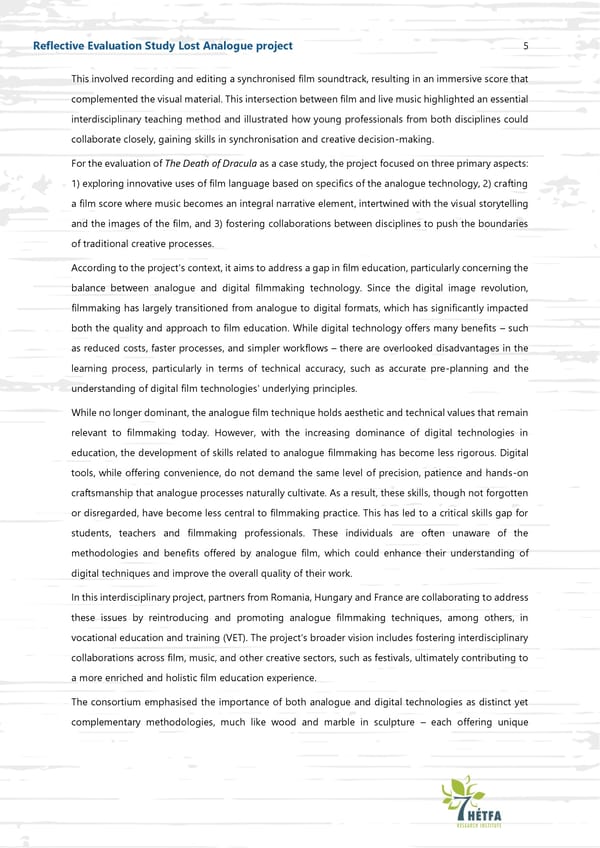5 Reflective Evaluation Study Lost Analogue project This involved recording and editing a synchronised film soundtrack, resulting in an immersive score that complemented the visual material. This intersection between film and live music highlighted an essential interdisciplinary teaching method and illustra ted how young professionals from both disciplines could collaborate closely, gaining skills in synchronisation and creative decision - making. For the evaluation of The Death of Dracula as a case study, the project focused on three primary aspects: 1) exploring innovative uses of film language based on specifics of the analogue technology, 2) crafting a film score where music becomes an integral narrative element, intertwined with the vi sual storytelling and the images of the film, and 3) fostering collaborations between disciplines to push the boundaries of traditional creative processes. According to the projects context, it aims to address a gap in film education, particularly concerning the balance between analogue and digital filmmaking technology. Since the digital image revolution, filmmaking has largely transitioned from analogue to digital formats, which has significantly impacted both the quality and approach to film education. While digital technology offers many benefits such as reduced costs, faster processes, and simpler workflows there are overlooked disadvantages in the l earning process, particularly in terms of technical accuracy, such as accurate pre - planning and the understanding of digital film technologies underlying principles. While no longer dominant, the analogue film technique holds aesthetic and technical values that remain relevant to filmmaking today. However, with the increasing dominance of digital technologies in education, the development of skills related to analogue filmmaking has become less rigorous. Digital tools, while offering convenience, do not demand the same level of precision, patience and hands - on craftsmanship that analogue processes naturally cultivate. As a result, these skills, though not forgotten or d isregarded, have become less central to filmmaking practice. This has led to a critical skills gap for students, teachers and filmmaking professionals. These individuals are often unaware of the methodologies and benefits offered by analogue film, which co uld enhance their understanding of digital techniques and improve the overall quality of their work. In this interdisciplinary project, partners from Romania, Hungary and France are collaborating to address these issues by reintroducing and promoting analogue filmmaking techniques, among others, in vocational education and training (VET). The projects broader vision includes fostering interdisciplinary collaborations across film, music, and other creative sectors, such as festivals, ultimately contributing to a more enriched and holistic film educa tion experience. The consortium emphasised the importance of both analogue and digital technologies as distinct yet complementary methodologies, much like wood and marble in sculpture each offering unique
 Celluloid Connections: Cultivating creative skills through analogue film and musical collaboration Page 5 Page 7
Celluloid Connections: Cultivating creative skills through analogue film and musical collaboration Page 5 Page 7